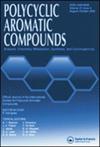取代苯胺6-(3,4,5-三甲氧基苯基)蝶啶衍生物的设计、合成及潜在细胞毒性体外评价
IF 2.6
3区 化学
Q2 CHEMISTRY, ORGANIC
引用次数: 0
摘要
设计、合成了一个新的目标化合物库(9a-j),并通过1HNMR、13CNMR和质谱技术对其进行了充分的表征。筛选目标化合物的细胞毒活性。本文章由计算机程序翻译,如有差异,请以英文原文为准。
Design and Synthesis of Substituted Anilino 6-(3,4,5-Trimethoxyphenyl)Pteridine Derivatives and Invitro Evaluation as Potential Cytotoxic Agents
A new library of target compounds (9a-j) was designed, synthesized, and fully characterized by 1HNMR, 13CNMR, and mass spectroscopy techniques. The target compounds were screened for their cytotoxic properties against cancer cell lines Colo-205, MCF-7, A549, and A2780 by employing the MTT assay, using the etoposide as the positive control. Among the newly synthesized target compounds, four compounds 9b-9d and 9j exhibited superior cytotoxic properties to the reference standard (etoposide). In particular, compound 9b was more cytotoxic against all four cell lines with IC50 in the range of 0.016 to 0.17 μM. Further 9b is more selective toward A549 and followed by MCF-7. Molecular docking studies of all the target compounds were carried out against hDHFR to see the binding interactions and binding affinities. Ligands 9b and 9c have the highest binding affinities toward hDHFR and these results substantiate the experimental findings. The MEC was analyzed for the most potent compounds 9b and 9c. All the ligands have passed the Insilico ADME properties and haven‘t violated more than one Ro5.
求助全文
通过发布文献求助,成功后即可免费获取论文全文。
去求助
来源期刊

Polycyclic Aromatic Compounds
化学-有机化学
CiteScore
3.70
自引率
20.80%
发文量
412
审稿时长
3 months
期刊介绍:
The purpose of Polycyclic Aromatic Compounds is to provide an international and interdisciplinary forum for all aspects of research related to polycyclic aromatic compounds (PAC). Topics range from fundamental research in chemistry (including synthetic and theoretical chemistry) and physics (including astrophysics), as well as thermodynamics, spectroscopy, analytical methods, and biology to applied studies in environmental science, biochemistry, toxicology, and industry. Polycyclic Aromatic Compounds has an outstanding Editorial Board and offers a rapid and efficient peer review process, as well as a flexible open access policy.
 求助内容:
求助内容: 应助结果提醒方式:
应助结果提醒方式:


